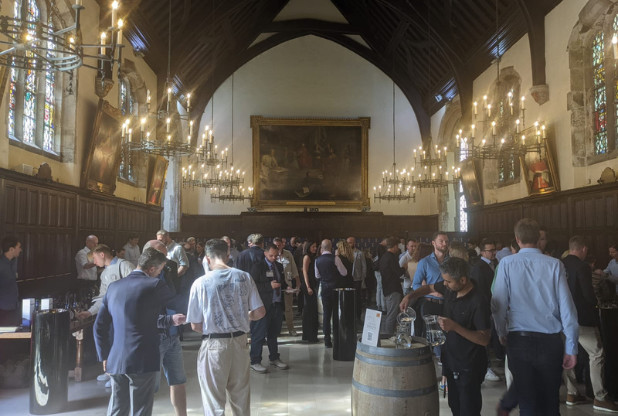
Food and wine the focus at Bibendum tasting
Yesterday (May 24), Bibendum welcomed the trade to its ‘A World of Fine Wine’ spring cellar-tasting featuring Old and New World regions with one notable exception – Bordeaux.
“Bordeaux is our main focus when it comes to fine wine so we just wanted to showcase everything else we can do when it comes to fine wine,” said Elona Hesseling, head of brand communications at Bibendum.
“A lot of the producers showcased today are part of our core range as well, so, for some of them, these are the very top parcels and limited-edition wines, whereas other producers are just purely fine wines, so it’s a bit of a mix,” Hesseling continued, amidst the tastings’ stunning display in the Old Hall, Lincoln's Inn.
- Read more: ‘Minimal’ approach majors at Deep Down Under
For Bibendum, this tasting was about showing the top of its portfolio in isolation (there will be a Bordeaux-specific tasting in September), as opposed to a shop window for volume drivers by the glass.
On the Portugal stand, for example, was the 1888 Adelaide Tributa ‘very very old’ Port, rather than a measly ‘very old’ port.
Despite the absence of Bordeaux, France was still well-represented by the likes of R. Pouillon Et Fils, Domaine Michel Mangnien and Bibendum newcomers Château La Nerthe.
The on-trade represents a large portion of Bibendum’s customer base and its influence was on full display in the Old Hall.
“There seems to be a real rise in Asian cuisine, and not just in restaurants but in hotels too,” said Andrew Craig, wine buyer at Bibendum owner C&C Group.
“We’ve been working with the Peninsula Hotel, opening in September, which is probably going to be one of the top hotels in the country and we’ve just built an Asian portfolio around that opportunity. We’ve been working with Changyu Moser for a few years anyway but we’ve also just started working with IWA Sake, who are blending all the best Sakes around the country into a kind of Dom Perignon of Japan,” Craig added.
With an in-house insight team by the name of Proof, Bibendum can blend years of experience in the trade with data and analysis. The emergence of Asian cuisine as a dominant food trend has led to new additions.
“It’s not just necessarily Asian wines that go with Asian cuisine. For example, we just brought in a Santorini Assyrtiko which goes amazingly with Asian food,” continued Craig.
However, the inclusion of the likes of Santo Wines from Greece and Royal Tokaji from Hungary is not necessarily to the detriment of traditional wineries in the portfolio.
“Look at Rioja for example, we have Bhilar which is very modern, with very little oak, and a very natural winemaking style, representing the new wave of Rioja and then right next to it, Ramirez de Ganuza, which is much more traditional in style with lots of new oak, lots of structure and lots of ageability,” said Craig.
“So it’s quite interesting to be able to do that as well, to have wines from the same region, similar terroirs with completely different styles, and that plays into the hands of the restaurants as well, we can go to more hipster restaurants with a Bhilar or we can go with the Ganuza at the more traditional places.”
Looking ahead for Bibendum – and Craig specifically – more and more lesser-known styles and regions will likely come to the fore.
“I think there’s a lot of opportunity in Eastern Europe, I think probably more at the entry-level than in this [fine wine] context, but you get some great wines from Moldova and Romania, and again, kind of going back to what I was saying about Rioja, it’s not just the new countries, it’s also about new regions within old countries,” Craig added.
And one such region is Bordeaux, where Craig believes there’s still untapped potential.
“One thing I really want us to try and find is a really new style of Bordeaux. Bordeaux is really important to us and we have a big tasting in September just for Bordeaux, but there seems to be a growing trend outside of the classic style of Bordeaux,” said Craig.
“Can we use different grape varieties outside of the three or four, can we change the winemaking style to be slightly lower intervention, less ageing, less oak and with more freshness? I’ve tasted four or five wineries that we haven’t signed up yet and I want to go out in September and taste and see because I definitely think there’s an opportunity there as well.”
Craig’s idea was inspired by a dinner with a notable Cinsault producer who had a penchant for natural wine styles.
“He [the producer] was talking about all these natural styles of wines that he drinks from Bordeaux and that kind of lit the spark that started this,” said Craig.
“It will be nice to overlay that with Proof insights as well and back it up with analytics. Art and science working together, it’s a good metaphor for wine in general,” Craig concluded.




